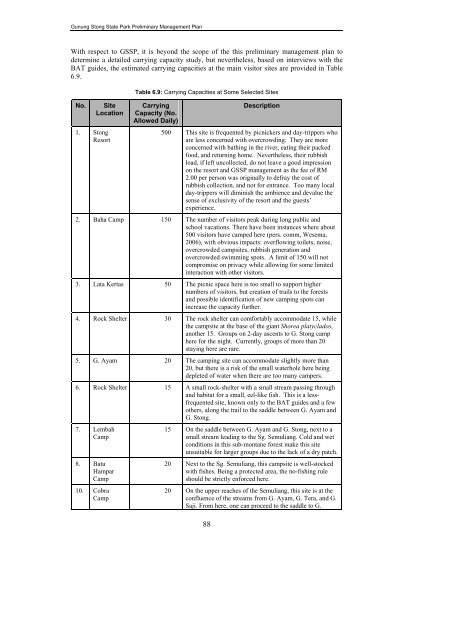FINAL VERSION FOR APPROVAL - Sdn Bhd - WWF Malaysia
FINAL VERSION FOR APPROVAL - Sdn Bhd - WWF Malaysia
FINAL VERSION FOR APPROVAL - Sdn Bhd - WWF Malaysia
Create successful ePaper yourself
Turn your PDF publications into a flip-book with our unique Google optimized e-Paper software.
Gunung Stong State Park Preliminary Management Plan<br />
With respect to GSSP, it is beyond the scope of the this preliminary management plan to<br />
determine a detailed carrying capacity study, but nevertheless, based on interviews with the<br />
BAT guides, the estimated carrying capacities at the main visitor sites are provided in Table<br />
6.9.<br />
No.<br />
Site<br />
Location<br />
1. Stong<br />
Resort<br />
Table 6.9: Carrying Capacities at Some Selected Sites<br />
Carrying<br />
Capacity (No.<br />
Allowed Daily)<br />
88<br />
Description<br />
500 This site is frequented by picnickers and day-trippers who<br />
are less concerned with overcrowding. They are more<br />
concerned with bathing in the river, eating their packed<br />
food, and returning home. Nevertheless, their rubbish<br />
load, if left uncollected, do not leave a good impression<br />
on the resort and GSSP management as the fee of RM<br />
2.00 per person was originally to defray the cost of<br />
rubbish collection, and not for entrance. Too many local<br />
day-trippers will diminish the ambience and devalue the<br />
sense of exclusivity of the resort and the guests’<br />
experience.<br />
2. Baha Camp 150 The number of visitors peak during long public and<br />
school vacations. There have been instances where about<br />
500 visitors have camped here (pers. comm, Wesema,<br />
2006), with obvious impacts: overflowing toilets, noise,<br />
overcrowded campsites, rubbish generation and<br />
overcrowded swimming spots. A limit of 150 will not<br />
compromise on privacy while allowing for some limited<br />
interaction with other visitors.<br />
3. Lata Kertas 50 The picnic space here is too small to support higher<br />
numbers of visitors, but creation of trails to the forests<br />
and possible identification of new camping spots can<br />
increase the capacity further.<br />
4. Rock Shelter 30 The rock shelter can comfortably accommodate 15, while<br />
the campsite at the base of the giant Shorea platyclados,<br />
another 15. Groups on 2-day ascents to G. Stong camp<br />
here for the night. Currently, groups of more than 20<br />
staying here are rare.<br />
5. G. Ayam 20 The camping site can accommodate slightly more than<br />
20, but there is a risk of the small waterhole here being<br />
depleted of water when there are too many campers.<br />
6. Rock Shelter 15 A small rock-shelter with a small stream passing through<br />
and habitat for a small, eel-like fish. This is a lessfrequented<br />
site, known only to the BAT guides and a few<br />
others, along the trail to the saddle between G. Ayam and<br />
G. Stong.<br />
7. Lembah<br />
Camp<br />
8. Batu<br />
Hampar<br />
Camp<br />
10. Cobra<br />
Camp<br />
15 On the saddle between G. Ayam and G. Stong, next to a<br />
small stream leading to the Sg. Semuliang. Cold and wet<br />
conditions in this sub-montane forest make this site<br />
unsuitable for larger groups due to the lack of a dry patch.<br />
20 Next to the Sg. Semuliang, this campsite is well-stocked<br />
with fishes. Being a protected area, the no-fishing rule<br />
should be strictly enforced here.<br />
20 On the upper reaches of the Semuliang, this site is at the<br />
confluence of the streams from G. Ayam, G. Tera, and G.<br />
Saji. From here, one can proceed to the saddle to G.
















